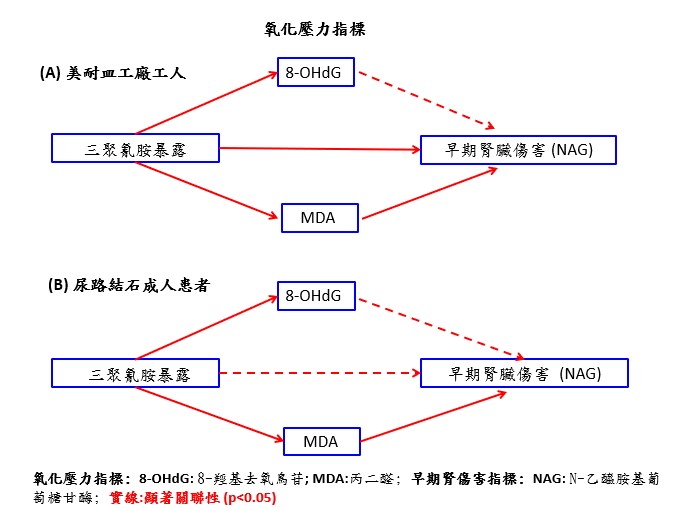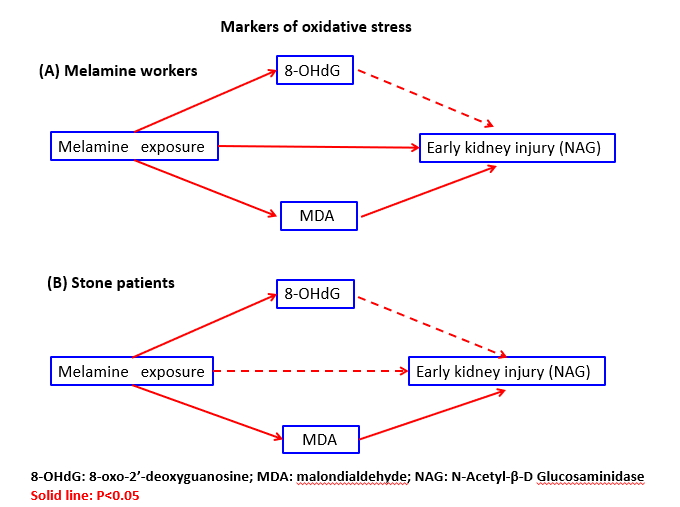環境中三聚氰胺暴露可透過氧化壓力引發早期腎臟傷害
環境中三聚氰胺暴露可透過氧化壓力引發早期腎臟傷害
三聚氰胺是一種人類廣泛使用製造日常物品的化學物質。在2008年爆發三聚氰胺毒奶粉事件,引發學界與一般大眾的關注! 儘管經過許多的預防措施,三聚氰胺汙染依然廣泛存在於我們環境中。近期包含美國與台灣等針對一般大眾族群的研究,均發現絕大多數尿液中仍可偵測出三聚氰胺的存在。而環境中三聚氰胺的暴露,其中一個可能來源是日常生活中常使用到的三聚氰胺製成的美耐皿器皿。這些器皿在接觸較高酸性或高溫的液體會增加三聚氰胺的釋出。此外,除過去三聚氰胺被摻假於食品中來提升蛋白質的偵測量,亦可能在食品製造過程中發生三聚氰胺汙染而被人體所攝入。
由於百分之九十的三聚氰胺經攝取後約24小時會經由尿液排出,因此推論腎臟可能最容易受到三聚氰胺的傷害。除了在2008年毒奶粉事件因添加大量的三聚氰胺引發兒童發生急性腎毒害,我們研究團隊過去也發現長期低劑量的三聚氰胺暴露在成年人亦可增加尿路結石與腎功能惡化的風險。
我們研究團隊過去曾提出長期低劑量的三聚氰胺暴露可能透過氧化壓力增加進而導致尿路結石生成與早期腎臟傷害的假說。為了驗證這個假說,我們針對80位在美耐皿工廠工作的工人與309位含鈣尿路結石的成人患者進行研究,以了解他們尿液中三聚氰胺量與尿液中氧化壓力指標(丙二醛與8-羥基去氧鳥苷)間的關聯性。結果發現在這兩個族群的研究,其尿液中三聚氰胺量與尿液中氧化壓力指標(丙二醛與8-羥基去氧鳥苷)均呈現顯著正相關。該結果意謂三聚氰胺暴露在人體內可導致氧化壓力增加。此外,我們亦利用結構方程模型,來探討三聚氰胺所引發的氧化傷害在腎臟腎小管傷害中所貢獻的程度,發現透過丙二醛路徑可貢獻36%-53%對早期腎小管傷害指標(N-乙醯胺基葡萄糖甘酶)的影響。
總結,我們的研究結果支持環境中低劑量三聚氰胺暴露,在人類會增加氧化壓力,進而可引發早期腎臟傷害。因此對於三聚氰胺的風險評估與預防,特別在一些高風險或易感性族群上,宜更加謹慎小心!
圖形摘要

應用與亮點:
1. 本研究為全世界第一篇人類研究,證實環境中低劑量三聚氰胺暴露可透過氧化壓力引發早期腎臟傷害。
2. 未來對於三聚氰胺的風險評估與預防,特別在一些高風險或易感性族群上,宜更加謹慎小心。
【研究團隊】
團隊成員:劉家駒、謝翠娟、吳佳芳、李建宏、蔡宜純、黃琮懿、溫聖辰、李政學、錢祖名、李永進、黃書彬、李經家、周以和、吳文正、吳明蒼
代表單位:環境醫學中心與世代研究中心
團隊簡介:我們團隊為跨領域研究團隊,成員主要來至高醫環境醫學中心與世代研究中心的尿路結石研究團隊,包含臨床醫學(泌尿學科與腎臟學科)、基礎研究、公共衛生等領域專家所組成,長期針對三聚氰胺對人體健康影響之議題進行研究。
研究聯繫Email:ccliu0204@gmail.com
【論文資訊】
論文出處:Journal of Hazardous Materials. 2020年9月; 396期(卷): 122726頁.
全文下載:https://www.sciencedirect.com/science/article/abs/pii/S0304389420307159?via%3Dihub
Chronic low-dose melamine exposure can cause early kidney injury via increased oxidative stress
Chronic low-dose melamine exposure can cause early kidney injury via increased oxidative stress
Melamine, a chemical widely used in the production of many daily used products, emerged as a public health concern after 2008 toxic milk scandal. However, melamine contamination still remains pervasive in our environment even after several measures for prevention. It could still be detected in most urine samples obtained from the general populations of countries including US and Taiwan recently. One probable source of environmental melamine exposure is the commonly used melamine-made household products including break resistant melamine tableware from which can migrate substantial amounts of melamine, especially in high acidic soups or soups served at high temperatures. In addition to use as a food adulterant, melamine might also be a contaminant during food production.
Because ninety percent of melamine intake is excreted in urine within 24 hours, our kidneys may be more susceptible to melamine. In addition to acute nephrotoxicity happened in children by high-dose melamine added to powdered milk formulas during the 2008 toxic milk scandal, our study team has found a long-term low-dose melamine exposure could increase the risk of adverse kidney outcomes, including the urolithiasis formation and the deterioration of kidney function in adults.
We have suggested that one probable mechanism through which chronic low-dose melamine exposure leads to stone formation and early kidney injury may be via increased oxidative stress. In order to investigate the hypothesis, we conducted two human studies in 80 workers from melamine tableware manufacturing factories (melamine workers) and 309 adult patients with calcium urolithiasis (stone patients) to evaluate the relationships between urinary melamine levels and two urinary biomarkers of oxidative stress, 8-oxo-2'-deoxyguanosine (8-OHdG) and malondialdehyde (MDA). Both human studies showed urinary melamine levels to be significantly and positively correlated with urinary 8-OHdG and MDA, which indicated melamine exposure could increase oxidative stress. Additionally, we found that MDA mediated 36%-53% of the total effect of melamine on a biomarker of renal tubular injury, N-Acetyl-β-D Glucosaminidase (NAG).
In conclusion, our findings suggested the exposure to low-dose environmental melamine could increase oxidative stress and further risk of early kidney injury in human. The risk assessment of melamine and suggestions of prevention should also be carefully considered especially when considering its effect on susceptible populations.
Graphical Abstract:

Application and Highlights:
1.This is the first report in literature to confirm the exposure to low-dose environmental melamine could increase oxidative stress and further risk of early kidney injury in human.
2.The risk assessment of melamine and suggestions of prevention should be more carefully considered especially on susceptible populations in the future.
Research Team Members: Chia-Chu Liu, Tusty-Jiuan Hsieh, Chia-Fang Wu, Chien-Hung Lee, Yi-Chun Tsai, Tsung-Yi Huang, Sheng-Chen Wen, Cheng-Hsueh Lee, Tsu-Ming Chien, Yung-Chin Lee, Shu-Pin Huang, Ching-Chia Li, Yii-Her Chou, Wen-Jeng Wu, Ming-Tsang Wu
Representative Department: Research Center for Environmental Medicine and Cohort Research Center
Introduction of Research Team: Our team is a cross-disciplinary research team that are assembled by different experts from the fields of clinical medicine (urology and nephrology), basic science, and public health. Our research is focused on the impact of melamine exposure on human’s health.
Contact Email: ccliu0204@gmail.com
Publication: Journal of Hazardous Materials. 2020 Sep; 396: 122726
Full-Text Article: https://www.sciencedirect.com/science/article/abs/pii/S0304389420307159?via%3Dihub


